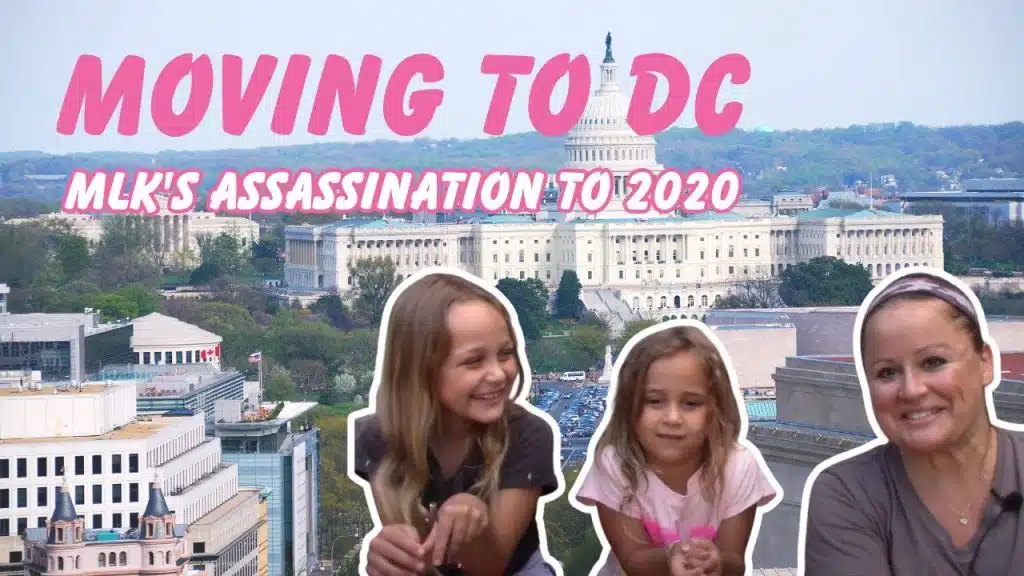History of Washington DC
We’re back with our last installment of DC history with the DC Real Estate Mama. In this final part of our series, we’re going to explore the period from the late 1960’s to our modern-day—which includes riots, crime, corruption, and recovery through the decades. If you’ve never heard of Marion Barry, you’re also going to be hearing a lot about the good and bad antics of this longtime DC mayor.
Martin Luther King’s Assassination
Let’s jump back in at April 4th, 1968. This was a massive turning point that reshaped the history of DC and many other parts of the country. When news of the assassination of Martin Luther King broke, riots ensued in several cities—and DC was one of them. For 4 days, unrest raged and decimated several neighborhoods in the area.
14th and U Street, which was known as “Black Broadway,” was home to several jazz clubs, music theaters, and black-owned businesses. After the riots, this area was completely destroyed. Additionally, 7th Street down to the National Mall also saw intense devastation. While housing in DC took the brunt of the damage from these riots, the H Street corridor—a major shopping district at the time—also suffered heavy losses. Other affected areas included Rhode Island Avenue, parts of Anacostia, and a variety of spots throughout DC that are too numerous to catalog.
In total, 900 businesses, 700 homes, and nearly 400 liquor stores were smashed, looted, and destroyed. To end the conflict, 13,000 troops were sent in to occupy the city—the highest amount of troops that had been seen in DC since the Civil War. It took 30 years for some of these neighborhoods to recover; to understand why post-riot rebuilding took so long, it’s important to understand what was happening in DC from the 1970s-1990s.
Neighborhoods Affected By Riots
In 1969, Nixon came into office and vowed to target crime in DC. In 1970, he passed a DC crime bill that included a variety of features—including the “No-Knock” rule. This meant that police could enter a structure without knocking or announcing their presence. Around this time, the Vietnam War was escalating and a major economic recession was looming. There were many protests, therefore, going on around the city for these and other reasons.
The riots put a wrench in the growth of many DC neighborhoods. Georgetown, for example, was a shopping area with restaurants and plenty of mom-and-pop stores. It remained supported by students at Georgetown as well as Washingtonians looking for entertainment—and this didn’t change much throughout the 1970’s and 1980’s.
Dupont Circle, meanwhile, was a little bohemian neighborhood in the 1970’s that was popular with the gay community. It was home to the country’s first gay bookstore, Lambda Rising, which opened in 1974. Logan Circle, however, remained decimated by the riots—the neighborhood was overrun by drug dealers, prostitutes, and many empty and boarded-up buildings. This extended to the eastern neighborhoods as well; for many years after the riots, people would not travel east of Connecticut Avenue and the 17th Street area.
The Rise Of Marion Barry
In 1973, DC passed the Home Rule Act, where Congress gave the power of DC over to the local city council and then-mayor, Walter Washington. Although he had been appointed mayor in 1967, the Home Rule Act made it official. He acted as DC mayor from 1975-1979. In 1976, Metro opened in DC, with Marion Barry becoming the next mayor from 1979-1991—serving a total of 3 terms. The Washington Post famously said, “To understand the District of Columbia, one must understand Marion Barry.”
Marion Barry did much to advance the city forward through the Civil Rights era, and he was largely effective in his earlier years as mayor of the city. There was, however, much corruption rooted throughout this time—which didn’t become evident until later terms.
The 1980s And The Crack Epidemic
In the early 1980’s, DC saw a real estate boom that resulting in changing neighborhoods. A huge punk scene was emerging, taking hold in Georgetown and Dupont Circle. A counterculture movement in Dupont Circle at the time had people congregating there, though Logan, Shaw, and U Street had still not recovered from the riots.
Marion Barry’s second term start edin 1983 and the situation was fairly poor. Drugs, prostitutes, and failing city services were rampant. Barry would walk through neighborhoods, talking about how he was going to fix the problems. People living in the housing projects in these communities would lean out of their windows and yell “Crackhead!”—an indication that there was something wrong. Barry’s service—as well as who served whom—was in question. As he made demands about what contractors were going to be hired to service the city, it was discovered that many of these people were his friends and financial supporters. They were inflating prices and then leaving it to the city to foot the bill, with Marion Barry behind it all.
Surprisingly, Barry won a third term in 1986, despite word circulating on what was really happening behind the scenes. Like other cities in America at the time, the crack epidemic hit DC hard. Previous to this era, cocaine was a “rich man’s drug,” but crack cocaine was cheaper and became available to more people. DC became rife with open-air drug markets, a street where people could drive through, roll down the window, honk their horn, and get quick access to drugs.
Hanover Place was a major location for drug activity, and in 1986 the city deployed 60 police officers to do round-the-clock patrolling of this area until they got it clean. Vacant buildings were boarded up, trash and cars were used to barricade the alleys, and Hanover Place was closed for business by the end of that year. While they were successful, the drug scene simply relocated south and to other neighborhoods like Trinidad and Shaw.
Escalating Violence In The 1990s
Violence was also escalating in DC. In 1986, the city saw 194 murders. By 1988, there were 434 murders that year, and by 1990 DC was the murder capital of the U.S. This same year, Marion Barry is caught on camera in an infamous drug bust—sending him to jail for 6 months. As a result, DC elected its first female mayor, Sharon Pratt. Still, in 1991, DC saw 482 murders. Between 1986 and 1993, there were 3,000 total murders in the city.
To end this violent, drug-filled era, the federal government granted funding to many cities to start redeveloping low-income housing—and DC was one of those cities. In 1991, the Metro added the Green Line to areas that previously had little public transportation options. This paved the way for redevelopment to start happening.
When Marion Barry got out of jail, he shockingly decided to run for City Council with the slogan: “He may not be perfect, but he’s perfect for DC.” In 1994, Barry is reelected as Mayor. At this point, the city is broke and filled with corruption. A board created in 1995 was tasked with overseeing city money—including the ability to overrule any financial decisions by the Mayor. By 1997, the Clinton administration stepped in to pull DC from its financial crisis. In doing so, all power was taken from Barry. This left him in charge of the city’s libraries, parks and recreation, and nothing else. He did not run for mayor again.
Gentrification And Marion Barry—Again
Gentrification came to DC in the 1990s and 2000s, which brings redevelopment of many neighborhoods. New houses, fancy condos, and renovations began. Anthony Williams is elected mayor in 1998, regaining control of DC’s money by 2001. He worked hard to get the city back on track, making many improvements that led to the revitalization of many DC areas. In 2004, Marion Barry resurfaced and runs for City Council—and won.
Even though he served multiple terms on City Council, a multitude of bad decisions led to a downward spiral. At one point, he voted against same-sex marriage, tested positive for cocaine, had unpaid taxes, has a massive collection of unpaid speeding and parking tickets, and made racist remarks against Asian people. Finally, City Council voted unanimously to strip him of all power. This history sums up how DC is run: it’s very forgiving. If you look up Marion Barry on DC.gov’s mayor’s office page, he’s described as a “Washington, DC hero.”
Real Estate Changes In DC
Real estate followed a predictable pattern with the ups and downs of the DC government. From the 1990s until 2008 and 2009, the real estate market was on a tear. While the market took a dive in the rest of the country, DC prices were only affected by about 15%. Thankfully, the city has proved to be fairly recession-proof. Most of the development during that time was halted, and many condos became apartments.
In 2006, Adrian Fenty became mayor of DC, followed by Vincent Gray in 2010 and Muriel Bowser in 2014—who still holds the position today. In 2012, the real estate industry starts to pick back up—and we’ve been in a run-up of prices ever since. Massive new developments have continued, and recovery has come in the form of expensive real estate. Many longtime residents have been forced out of their neighborhoods, which is a topic of much contention in the city. Others claiming to be “developers” are simply buying houses and flipping them, often with shoddy construction. Unsuspecting consumers have bought houses that later fall apart and have to be condemned.
History Marches On
History is being made in DC every single day. During the months I’ve spent researching our city’s history, we’ve experienced the coronavirus epidemic, the killings of unarmed black men and women by police, the ensuing riots, and civil unrest that appears to be here to stay. Many people are again fleeing DC, this time due to COVID-19 concerns. Most don’t want to live in close quarters with others, with condos quickly losing their appeal. The demand for people to buy houses with swimming pools and more land are currently very high.
Our city will move on to its next chapter, though hopefully it won’t be another wash/rinse/repeat cycle of fraud, corruption, population decline, people leaving DC, people moving back to DC, and recovery. It’s anyone’s guess, so we’ll just have to see!
If you liked the video and want to subscribe, click here!





